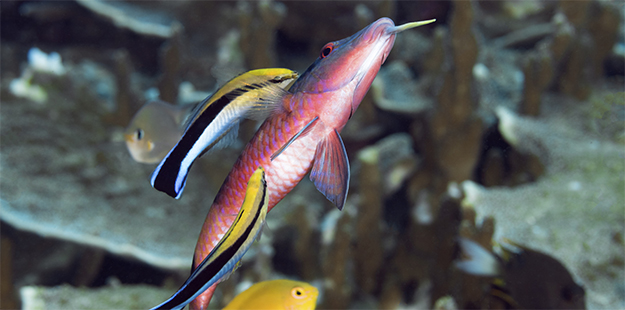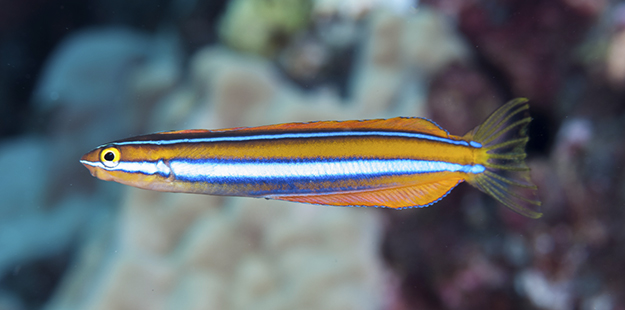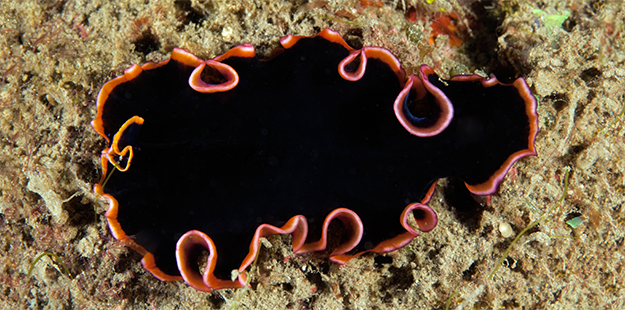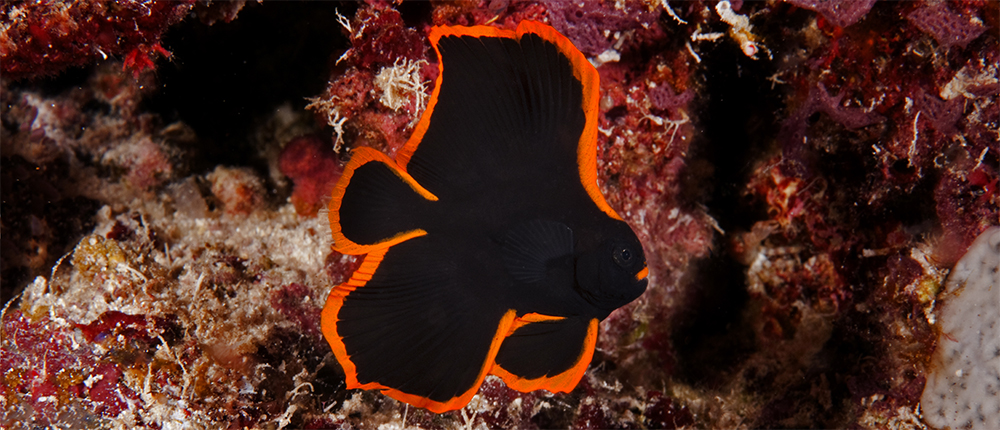Wakatobi’s Imposters
False advertising
The reefs of Wakatobi are filled with cleaning stations, and it can be quite entertaining to watch a toothy predator pause with jaws agape as a squadron of small fish and shrimp swarm over a big fish’s body and even into its mouth. These diminutive cleaners may advertise their services with unique darting and dancing motions, much like a human sign twirler at a car wash proclaiming “come on in.” But there may be interlopers hiding among those well-intention custodians.

It can be quite entertaining to watch bluestreak cleaner wrasse perform their services on a client. Photo by Walt Stearns
The cleaner wrasses have a number of imposters in the blenny family. Some blennies just like to hang out and cash in on the safety gained from being mistaken for a cleaner. Then there’s the bluestriped fangblenny, which mimics the juvenile bluestreak cleaner wrasse.

The sneaky bluestriped fangblenny will often cash in on the safety gained from being mistaken for a cleaner wrasse. Photo by Wakatobi Resort
But instead of picking parasites, this fangblenny may take a nip at the customer itself. This trick apparently works best on younger fish not yet wise to the deception, but the bluestriped also has a unique trick that helps hide its carnivorous actions. This fish’s namesake fangs can dispense a pain-numbing venom containing morphine-like opiods that keep the victim from feeling the nip.

Flatworms might appear to be tasty like a piece of candy, but will in fact leave a foul taste in it’s attackers mouth. Hence the reason why the pinnate spadefish in its juvenile stage bears a strong resemblance to flatworms like this. Photo by Wakatobi Resort
Youthful illusions
For some fish, imitation is a part of growing up. One clever survival strategy used by the young and vulnerable is to look like something that isn’t good to eat. A good example of this practice is the juvenile pinnate spadefish (pictured in the feature image at the top of the page), which has a dark body rimmed with an orange outline, giving it the appearance of a toxic flatworm. There are also species that don’t go the hazmat route, and instead employ deception to blend in and benefit from having safety in numbers.

Like a wolf in sheep’s clothing a juvenile masked grouper (left) will often blend into clouds of anthias allowing it to eat the smaller juvenile anthias within the school. Photos by Walt Stearns
A keen-eyed observer might notice that the clouds of anthias that swirl around Wakatobi reef tops may contain some slightly different-looking fish. These may be juvenile masked grouper, which take on the color patters of male purple anthias and join the shoal. The barramundi groupers are another group that engages in youthful masquerades. In their case it’s sweetlips that are being impersonated, and this may be because many predators seem to find the sweetlips distasteful.
Want to test your talents for spotting the imposters of the coral reefs? There are more than 40 dive sites around Wakatobi Resort where examples of marine life mimicry happen daily. It’s up to you to determine if things are really as they seem.
To make your plans for a Wakatobi visit, complete a quick trip inquiry at wakatobi.com or email office@wakatobi.com.
Visit us on Facebook.


